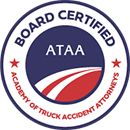How Big Is a Truck’s Front Blind Spot?

How big is a truck’s front blind spot? Let’s discover those answers so that you can travel safely and mitigate the risks of traveling near these large vehicles.
What Is a Truck’s Front Blind Spot?
You can find these blind spots directly in front of the truck’s cab. In these no-zones, the driver’s view is very obstructed due to the height and size of the vehicle. Since the driver is elevated, they cannot see anything directly in front of their vehicle. This blind spot can stretch for several feet. As a result, smaller vehicles entering this zone are invisible to the truck driver.
How large are these spots? In most cases, the front blind spot can extend up to 20 feet from the front of the truck per the Federal Motor Carrier Safety Administration (FMCSA). But that is not the same for all vehicles. The exact size can vary depending on the truck’s design and the driver’s seating position. For example, taller trucks have larger blind spots. This is due to the driver sitting higher off the ground. As a result, they have a more obstructed view of the area directly in front of the vehicle.
The position of the truck driver’s seat and the height of the cab can also affect the size of the blind spot. While some truck designs can boost the driver’s visibility, others may have more limited views. Fortunately, some modern trucks have advanced safety technology, including front-facing cameras and sensors. All these devices can help to limit the risks associated with blind spots. However, not all trucks are equipped with these technologies. If the driver has an older vehicle, they may have larger blind spots due to a lack of visibility aids.
No matter the size, vehicles and pedestrians in this zone are at high risk. Not only does the truck driver not see them, but they will not have enough time to react in an emergency.
These Are Dangerous Areas
All blind spots are dangerous, but drivers need to pay attention to those in front of a large commercial vehicle. If you cannot see the truck driver, they cannot see you either. If traffic suddenly slows or there is a sudden stop, the driver may not have enough time to brake or maneuver to avoid a collision. This can lead to a rear-end crash. With commercial trucks’ large weight and size, even a minor collision can cause catastrophic damage.
However, that is not the only danger. Trucks need more time and distance than passenger vehicles to come to a complete stop. If a car cuts in front of a truck and enters its blind spot, they might not have enough time to stop. According to the FMCSA, it takes trucks 40% longer to stop than other vehicles. In turn, that can set the stage for a rear-end collision.
On highways, smaller vehicles often merge in front of trucks without realizing they are entering the truck’s front blind spot. This is dangerous at high speeds. Unfortunately, the truck driver may be unable to break in time to avoid an accident.
Staying Out of the Truck’s Front Blind Spot
If you are another driver on the road, you will want to stay out of any blind spot, especially those in front of the larger truck. There are a few tips to follow to prevent any close encounters with these vehicles:
- Never “cut off” a truck: In any situation, you will want to avoid passing in front of a truck. Many times, this can happen when merging or changing lanes. If you have to merge, you will want to make sure there is plenty of space and ensure the driver can see you clearly. You might want to follow this rule: always ensure you can see the truck’s entire front grille in your rearview mirror before merging.
- Give plenty of space on the road: Along with that, you need to maintain a safe distance when driving in front of a truck. The truck driver cannot see you if you are too close to the front. Always leave at least 20 feet of space between you and the large truck.
- Watch for turns: Despite their large size, these vehicles need extra space when making turns. Many times, you will see them swing wide to maneuver. In these cases, the front blind spot is even more dangerous. If you’re at an intersection and see a truck signaling to turn, give them extra space to complete their turn safely.
When traveling on the road, you will want to be cautious about the truck’s front blind spot. These spaces can often stretch up to 20 feet in front of the truck. Both truck drivers and motorists should be aware of this blind spot and take steps to avoid it.
Blind spots do not mean the truck driver can make moves on the road without checking for other vehicles. They still have to take precautions to keep other safe. Sometimes, they may act negligently and cause a trucking accident. In these cases, the legal team at the Trucking Injury Law Group can provide a free consultation about your situation.





